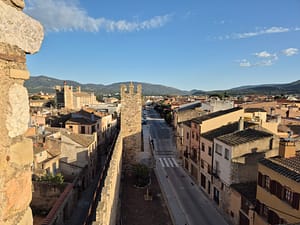I visited Conca de Barberà to witness how the grape trepat is being brought into the spotlight. The event was organised by the communication and public relations agency Mahala in collaboration with the local wine authorities.

Trepat has been cultivated in Conca de Barberà for centuries. Before phylloxera it counted for one third of the planted area. Now it has long been overlooked in favour of grapes like garnatxa and tempranillo. Traditionally used in rosé and cava, it is now revealing its potential for elegant, fresh and spicy red wines. The grape thrives in calcareous and clay-rich soils, and the cool nights of the region help preserve its natural acidity.
Typically low in alcohol, trepat offers high acidity, floral and spicy notes, and an earthy undertone. Winemakers are increasingly experimenting with whole-bunch fermentation, carbonic maceration, amphora and concrete eggs to highlight the grape’s unique personality. At the same time, organic and biodynamic practices are gaining ground.

A pioneer of the modern trepat in Conca de Barberà was Celler Carles Andreu, who made the first single-varietal red wine from the grape back in 2004. They were among the first to believe in its potential. Today led by Carles’ son Bernat, I particularly like their young unoaked trepats, that display finesse, delicate berry fruit, herbal touches and a distinctive peppery finish.

Mas Foraster has also made trepat a signature, using organic cultivation and often working with whole clusters and gentle extraction to emphasise elegance. Led by Ricard Sebastià Foraster, they make fresh trepats, with hints of raspberry, rose petals and light tannins. But with their Julieta – the name of both Ricard’s mother and daughter – they also offer a slightly more structured version of the grape.

Vidbertus represents a new generation of winemakers focused on organic viticulture and minimal intervention in the cellar. Their pure trepats, like Elixir, reflect the limestone soils of Conca de Barberà, showing vibrant acidity and a spicy profile.

Marta Pedra of Vins de Pedra practises organic viticulture and is in the process of certification. The wines carry a unique label design, created by her godfather and changed each year. Trempat sees careful use of new French oak, resulting in a wine that’s light and fragrant with red fruits, but also with refreshing menthol and liquorice and a delicate peppery note. An outdoor lunch at the farm offered a generous taste of everything grown and crafted on site—from freshly baked bread to fragrant olive oil and vibrant vegetables.
Rendé Masdéu, which lost its historic winery in the floods of 2019, has continued its work with trepat from a new facility. They produce both rosé and red styles with a balance between tradition and modernity.

Then there is Mas de La Pansa, a small-scale producer making limited quantities of artisanal trepat. Inma Soler focuses on organic cultivation, spontaneous fermentation, skin contact, and ageing in old oak or stainless steel. Her dessert wine Trepat Dulce was a winner at the final dinner.

We witnessed the modernist architecture of the region’s cooperatives, among the oldest in Spain, in buildings by Cèsar Martinell. But more than that: The cooperatives have also played an important role in keeping trepat alive. Castell D’Or, Cellers Domenys and Vinícola de Sarral have used the grape in their cava blends for decades. Now, they are also exploring its potential for elegant, varietal wines in both rosé and red styles.

The grape’s recent evolution in Conca de Barberà suggests a promising future. It would be perfect in today’s trendy bars. I would say it so far is at best in its young and unoaked versions. With growing attention from both winemakers and enthusiasts, this once-overlooked variety may well be on the path to a full-blown renaissance—not only in Spain, but on the international stage.
